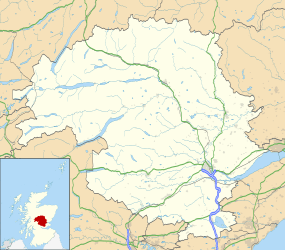Logierait
Coordinates: 56°38′51″N 3°40′47″W / 56.647558°N 3.679711°W
Logierait (Scottish Gaelic: Lag an Ratha - 'Hollow of the [Earth-Walled] Fort/Enclosure') is a village and parish in Atholl, Scotland. It is situated at the confluence of the rivers Tay and Tummel, 0.5 kilometres (0.31 mi) west of the A9 road in Perth and Kinross.
Nearby is an ancient ash tree, the Dule Tree of the district from which thieves and murderers were hanged.
Above the village is the site of a major early royal castle, perhaps the 'rath' of the place-name, still marked by a large ditch. This was probably the seat or caput of the mormaers of Atholl. The ancient promontory fort is marked by a huge 'Celtic' cross, a monument to the 6th Duke of Atholl (1814–1864).
The church is of early Christian origin, as shown by the presence of two Pictish cross-slabs: one in the churchyard, discovered in or before 1878; the other, identified in 1989, in the church. Both are classified as Class II Pictish stones (dressed stones, relief carving). The church's dedication is to Coeddi, Bishop of Iona in the early 8th century, perhaps the founder of the church here.[1] The present church building, however, dates from the early 19th century, and is protected as a category B listed building.[2]
The school dates from 1863 and was also built by the 6th Duke. It was designed by the Edinburgh architects R & R Dickson.[3]

Notable Residents
- Adam Ferguson, a leading figure of the Scottish Enlightenment was born and raised in Logierait.
- John McIntosh (1796–1853) Canadian politician born in Logierait
- Alexander Mackenzie (1822–1892), Canada's second Prime Minister, born in Logierait
References
- ↑ Fraser, Iain (2008), The Pictish Symbol Stones of Scotland, Edinburgh: Royal Commission on the Ancient and Historical Monuments of Scotland, ISBN 978-1-902419-53-4
- ↑ "Logierait Parish Church: Listed Building Report". Historic Scotland. Retrieved 16 May 2011.
- ↑ Dictionary of Scottish Architects: Dickson
| Wikimedia Commons has media related to Logierait. |
